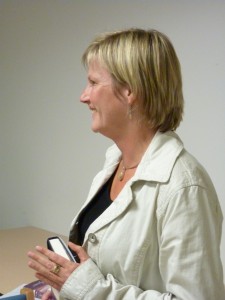On characters
- At December 03, 2011
- By Anne DeGrace
- In notebook
 0
0
 When I step onto the metaphorical page, my characters step with me. They are people I know in the way I know someone I’ve had a nodding acquaintance with for years, and who live with me in the same small town. I know some, but not all of their business, some of it only by hearsay. I know a little of their history; we may or may not have friends in common. And then one day we’re in the lineup together at the coffee shop; a conversation ensues, and I realize I didn’t know this person at all. From there, anything’s possible.
When I step onto the metaphorical page, my characters step with me. They are people I know in the way I know someone I’ve had a nodding acquaintance with for years, and who live with me in the same small town. I know some, but not all of their business, some of it only by hearsay. I know a little of their history; we may or may not have friends in common. And then one day we’re in the lineup together at the coffee shop; a conversation ensues, and I realize I didn’t know this person at all. From there, anything’s possible.
None of my characters are modelled on anyone entirely–acquaintance or old friend—but an amalgam of many, making the character on the page even less predictable than that coffee lineup acquaintance. To me, it’s the perfect situation, because I know just enough to get the character on the page but not too much that it colours the developing relationship. I love taking the little I know about a character and plunking him or her in a moment in history or an odd situation. I love taking voice and altering it to fit an era or circumstance.
While I never do character studies, in the back of my mind I am always considering the character’s sensory response to experiences, reactions, quirks of dialogue. It’s an intuitive thing rather than a calculated thing, and I love the uncertainty and the malleability of this approach.
Occasionally, this non-method fails me. When it does, I’m usually writing in a third person point of view, and then my methodology is simple: I write a couple of pages in first person, the voice comes, and the character is revealed. After that, it’s usually clear sailing.
Only once has a character walked into a scene unbidden: in Sounding Line I had my protagonist sitting in a club car on a train heading for Halifax, and a woman walked in—eccentric, a little flaky, strangely self-assured—who took me completely by surprise and then went on to become a major player in the narrative. I can’t explain it, and I’m way too practical to speak about muses or channeling, too sure of my sanity to suspect hallucinations. I’m just hugely grateful, and secretly hopeful it will happen again.
My favourite kind of book to write is a book in which there are lots of voices. Flying with Ameila was fun to write because of the scope of time—150 years—and the variety of voices, from age 11 through 95, and from myriad cultures and backgrounds. In the midst of writing that book I would close my eyes at night and let whoever had been closest to my keyboard that day whisper me to sleep.
This essay originally appeared in Open Book Ontario
